As an Amazon Associate I earn from qualifying purchases.
Dan Dan noodles are likely one of the few Sichuan dishes many Americans know about. Wheat noodles, tossed with sesame paste, soy and chile oil, topped with ground pork or some other meat. But this dan dan noodles recipe is a little different.
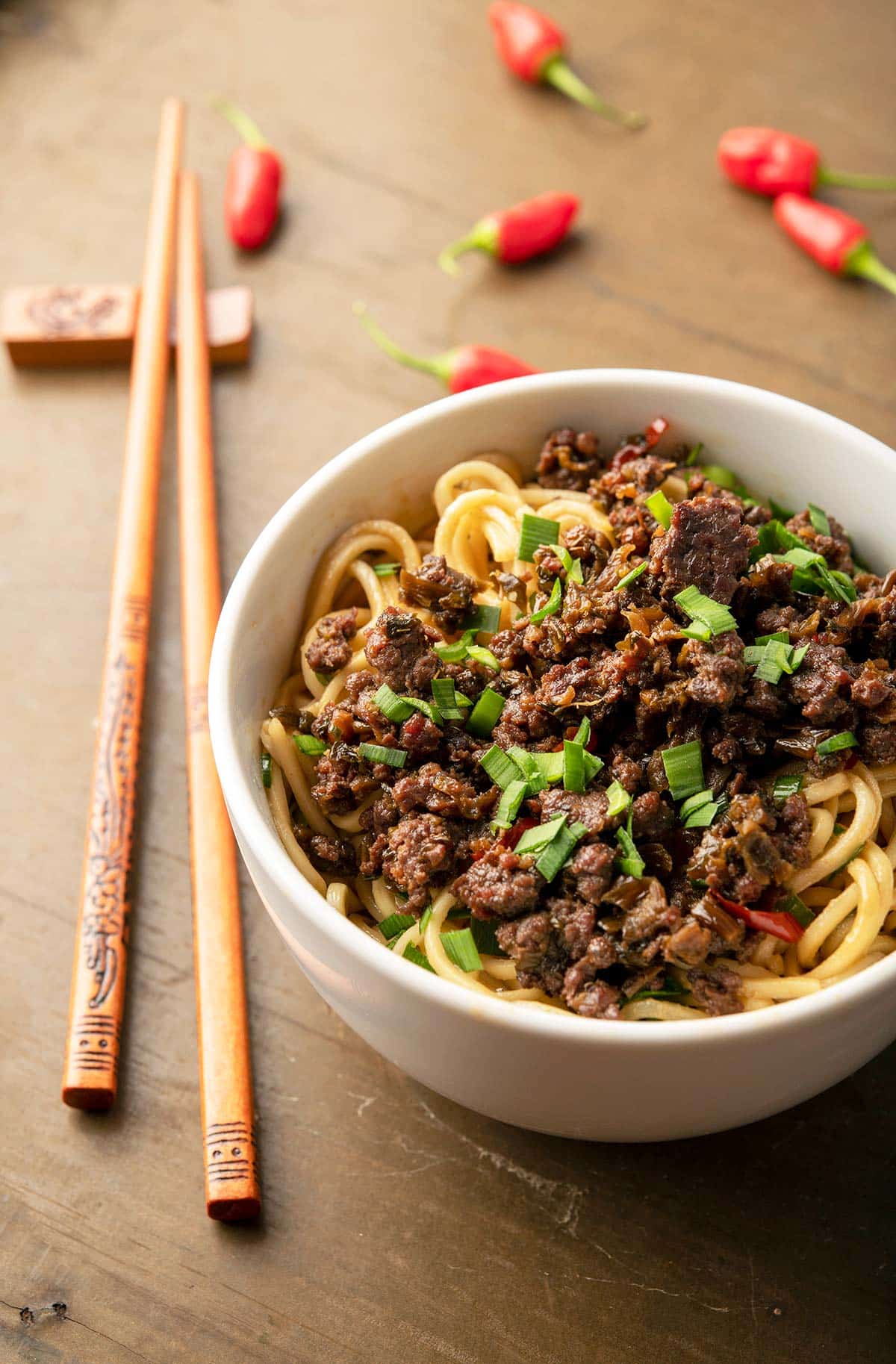
No matter which of the many variations you find, they are all street food, named for a shoulder pole used to carry the pots and ingredients for the noodles, and while its origins are in Sichuan, there are versions of it all over China, as well as here in the U.S.
So, I have to tell you that the first time I ate dan dan noodles, they were gross. It was like eating sweet peanut butter noodles. I swore off them as some nasty side note of Chinese cuisine, until I bought Fuchsia Dunlop’s book The Food of Sichuan. Dunlop, an Englishwoman, graduated from culinary school in Sichuan and is generally considered the authority on that province’s food in the English language. The book is amazing.
And in it are two dan dan noodles recipes, neither of which were sweet or peanut buttery. I later learned that what I disliked about what I’d eaten here was something Chinese chefs did to the dish to make it appeal to American palates. Go figure. Guess I don’t have a typical American palate.
I was especially struck by Mr. Xie’s dan dan noodles, which in Dunlop’s book use ground beef and not pork. The thought struck me immediately. Hey, I happen to have a lot of ground venison and duck in the freezer, and this would be awesome! For those of you squinching your noses, know that once you grind meat, it pretty much tastes like any other red meat.
Neither of the versions Dunlop includes in her book are soupy, which I like. American Chinese versions are often soupy, and it’s not my favorite with this flavor combination.
What are those flavors? Meaty, spicy but not overly so, rich from the sesame paste, a bit salty from both the soy, and the preserved mustard stems that are part of the traditional minced pork topping.
If you want to make this dan dan noodles recipe the way Dunlop does, you will need to get yourself to an Asian market. There are several unusual ingredients in it that are all vital to the flavor. That said, I will give you rough alternatives that are easier to find. It’ll taste different, but will be more accessible to most of you reading this. I’ll also link to online sources of these ingredients if you want to go that route.
- Chief among the special ingredients is Chinese preserved vegetable. Tianjin preserved vegetable or its cousin, yibin yacai. Both are long fermented mustard stems that, when you take them out of the packed or jar, look, well, not like mustard stems. But they are a great source of salty, savory flavor and are worth trying to get. Here’s where I found Tianjin Preserved Vegetable, and I bought Yibin yacai here. If you want to make real dan dan noodles you need one of these. But if you don’t feel like buying them, minced sauerkraut or kimchi will get you into the same galaxy, although they are not really that similar.
- Sesame paste. I know, you’re immediately thinking about buying tahini. And yes, if you have no Asian markets around, go for it. But the Chinese sesame paste doesn’t taste the same. but Dunlop gives us a recipe for making your own by toasting 2/3 cup of sesame seeds until nicely nutty and tan, then grind them well. Bring 5 tablespoons of neutral oil to 355°F and pour that over the ground, toasted seeds. You’ll be good to go.
- Chile oil. You can buy this in most supermarkets, or make it by pouring hot oil over ground hot peppers, with a spoonful of toasted sesame seeds. The general ratio is 4:1 oil to ground chiles, plus a small amount of toasted sesame.
- Sichuan peppercorn. No substitute. You need this. Asian markets all have it, and I buy my Sichuan peppercorns from Penzey’s. Yes, you can skip it, but there is no real alternative ingredient.
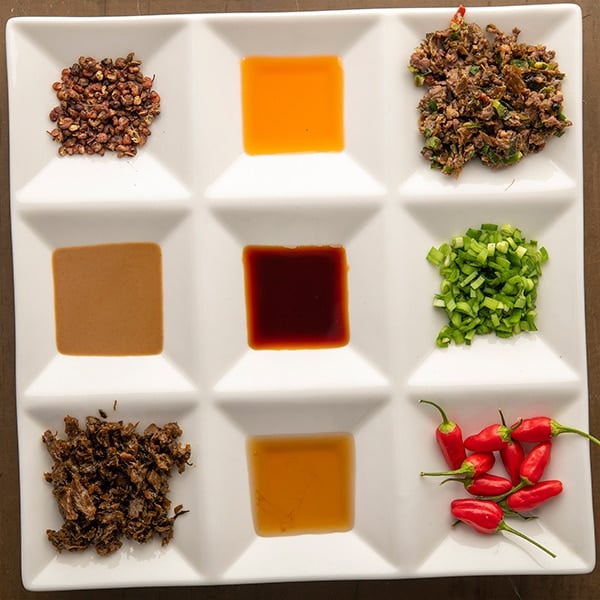
Everything else is easily obtainable from a supermarket. As for the noodles, you want Chinese wheat noodles, but Italian vermicelli is a decent substitute. Definitely check your supermarket’s Asian aisle, though, as they often have the Chinese noodles there.
Putting together an authentic dan dan noodles recipe requires a bit of forethought, but the cool thing is that once you have the ingredients and have made the topping, you are ready to make the noodles whenever you want for about a week, which is how long the topping will keep in the fridge.
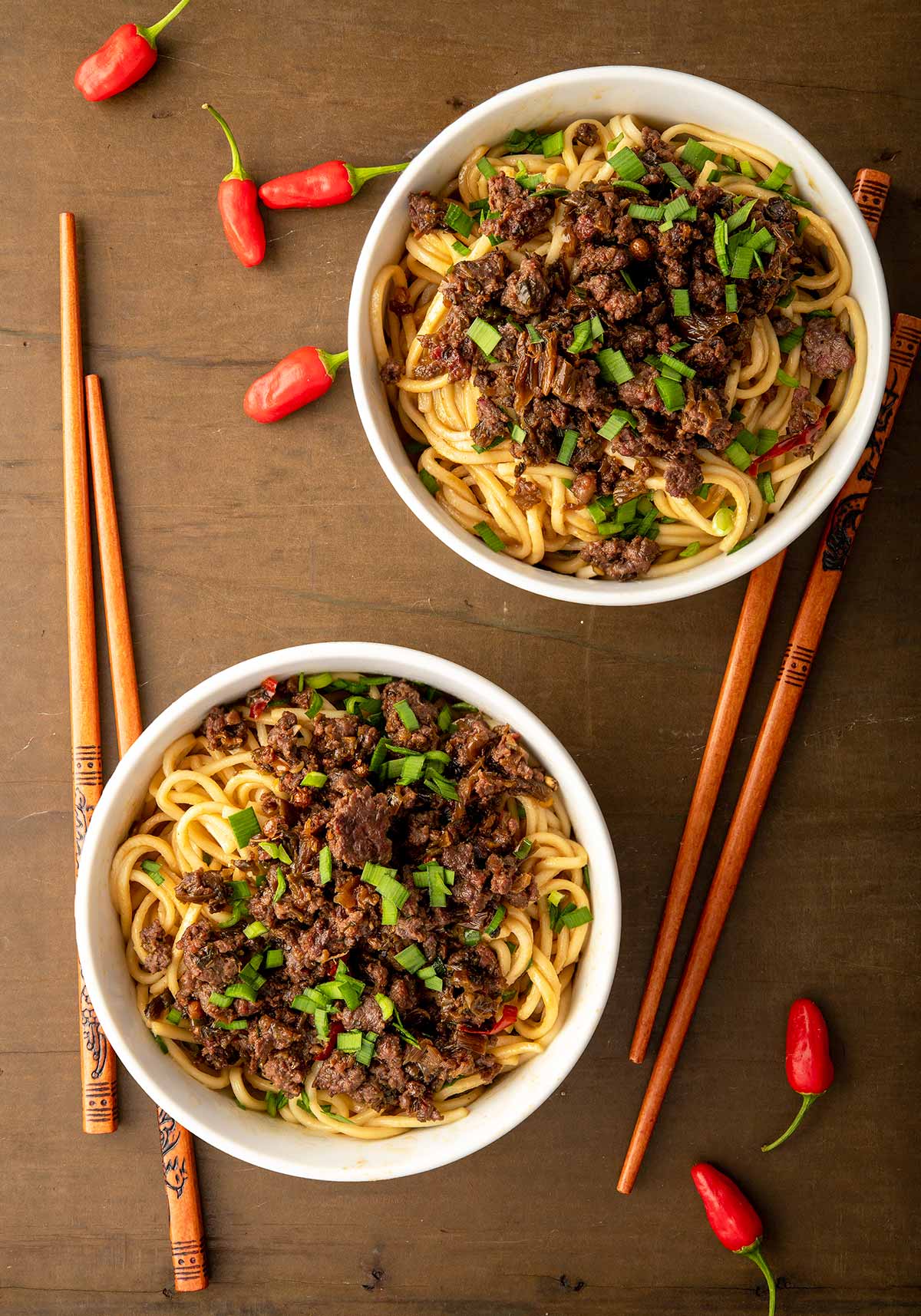
When it comes time to serve, the idea is to boil your noodles, make the topping while the water is heating, put a little of the sauce ingredients in each bowl, top with the meat, then let everyone mix and eat as they want.
If all this sounds like a long walk for a cup of coffee, keep in mind that I was skeptical, too. But once I made real deal dan dan noodles recipe, I was convinced. I think you will be, too.
Incidentally, I cook a lot of Sichuan food. You might want to try my recipes for fish fragrant chicken (or pheasant, or whatever), Sichuan rabbit with peanuts, or twice cooked pork.
If you liked this recipe, please leave a ⭐️⭐️⭐️⭐️⭐️ rating and a comment below; I’d love to hear how everything went. If you’re on Instagram, share a picture and tag me at huntgathercook.
Mr. Xie’s Dan Dan Noodles
Ingredients
TOPPING
- 1/4 cup peanut oil
- 3 to 10 small, hot chiles, fresh or dried, sliced or crumbled
- 1/2 pound finely ground venison, pork, beef or some other meat
- 1 teaspoon ground Sichuan pepper (optional)
- 2 ounces Tianjin preserved vegetable or yibin yacai, rinsed off and squeezed dry (optional)
- 3 teaspoons soy sauce
NOODLES
- 1 pound Chinese wheat noodles or vermicelli
- 4 teaspoons sesame paste
- 2 teaspoons sesame oil
- 4 tablespoons chile oil
- 4 tablespoon soy sauce
- 1 teaspoon ground Sichuan pepper (optional)
- 1/4 cup minced chives
Instructions
TOPPING
- Heat the peanut oil in a wok or heavy frying pan over high heat. When it's hot, add the chiles and stir fry about 30 seconds, until you can smell them. Add the ground meat and stir to combine. Stir fry over very high heat until the meat has browned, then add the remaining topping ingredients, toss to combine and cook for another minute or so. Turn off the heat.
NOODLES
- Before you even start the topping, get a large pot of water over a burner set over high heat. You want it to be boiling when you are done with the topping, although it's not critical that both are done at the same time.
- After the topping is ready and the water boiling, add the noodles and gently stir them so they don't stick to each other. These typically only need maybe 3 minutes or so to be ready, but follow the directions on the package.
- While the noodles are boiling, divide all the other noodle ingredients – except for the minced chives – among four deep bowls. To serve, give everyone some noodles over the sauce ingredients, add some topping and some chives, and let everyone stir and mix and eat!
Notes
Nutrition
Nutrition information is automatically calculated, so should only be used as an approximation.

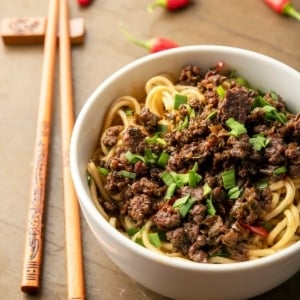
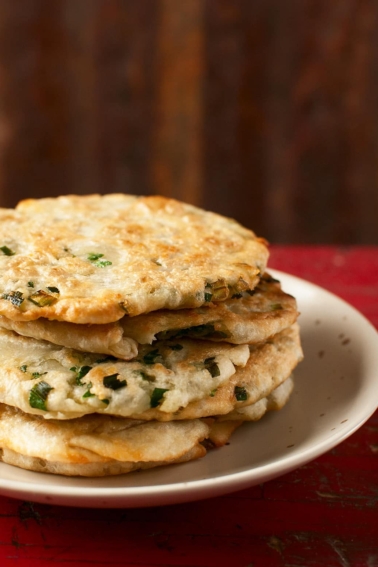

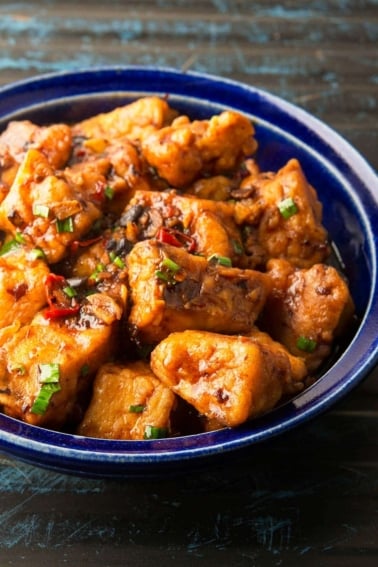
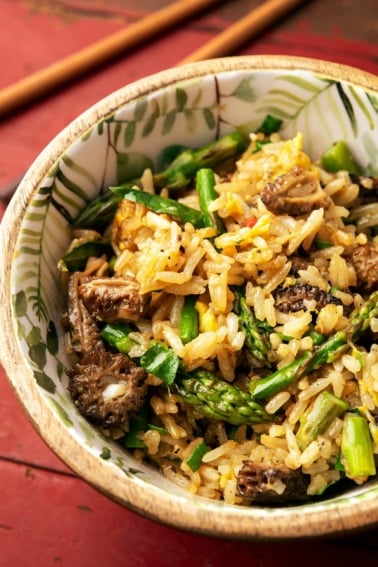
This recipe was so easy but amazing! Cooked it for myself a few weeks ago then company yesterday and everyone could not get enough!
The recipe caught my eye, so I went to work to make it happen. First, your endorsement of Fuschia Dunlop’s book was intriguing and I looked over some of the reviews – had to order this book, it arrived in a few days. Aside from being a beautiful book and well written, it’s also a great reference to help me find the specialty ingredients. Living in a small town in New Zealand doesn’t give me exactly heaps of options for sourcing unusual ingredients. We have one couple from Canton who runs a local produce and Asian grocery store. Their English is about as good as my Cantonese so I took my new book along, and with the pictures of the ingredients and Chinese script they easily directed me to the fresh noodles I was after, the pickled mustard, sesame paste and chili paste/oil. We grow our own birds eye chillies so used those – 10 of them. Made the dish last night exactly per your recipe (except swapped fresh garden spring onions for the chives), and it was amazing. Despite all the chillies, it was a wonderful well balanced heat. It was not too saucy and not too dry, just right. I’ll definitely keep this one on the rotation – thank you Hank, for another amazing recipe and the positive feedback on the book – a beautiful addition to my collection.
Hank, are you using fresh or dried noodles here?
For people looking for venison, I’ve been seeing it at Grocery Outlet as of late (both ground and medallions). Yeah, not local or hunted, but it works in a pinch.
Linda: Dried.
You went to the best source with Fuschia Dunlop.
Hank,
Your version is quite different from my recipe.
On the agenda for the weekend!
Enjoy the cool Minnesota weather – pushing 100 degrees here in Cary, NC this week.
Tad
We loved this dish. Took the neighbors a sample and they loved it so much that they made it later the same week. Easy and delicious. Wish I had more ground venison to make some more.
Just be careful with the sauce, easy to get too much in your bowl and get a little too pasty.
This was amazing. I started cooking szechuan food in LA in the late 1970s, and this is the best version of noodles that I’ve had. I didn’t have chili oil but I *did* have chili crisp from Fly By Jing, so I poured some of the chili oil in. My husband and I arm-wrestled over who got the leftovers. Thanks for the diversity of your recipes – I love Asian food and you make it very accessible. Have you heard of Fly By Jing? She makes a few szechuan dips / rubs and they are also very good.
This recipe was delicious and helped expose me to some new ingredients at the sometimes vexing Chinese Market here in Kansas City, MO. Used ground venison combined with some small, foraged chantrelle mushrooms and garden serrano peppers. The only issue I had with following the recipe was dividing the other noodle ingredients among the bowls. Do I try and split the tsp and tbsp 4 ways, or first combine and then distribute? Combining and distributing won the day. Did I make a misstep here or is there a better (right) way to do this?
Hank, I’ve never ever been disappointed by anything I’ve made from your books or blogs. You continue to inspire, educate, and challenge my culinary skills, and that’s just the way I like it! Thank you!
Rob: Thanks for the kind words! Yeah, as for the stuff in the bowls I just eyeball it. But yes, you could combine and distribute. That will work, too.
Always enjoy your recipes! I’ve done a similar ATK recipe, spicy pork and noodles but I find many of their recipes while good, are geared towards the American palate. Looking forward to trying yours.
OK, I’m confused. You explain that the preserved vegetable is mustard stem, which I have heard of but not cooked with yet. But the Tianjin is apparently cabbage?
Guy: Yes, they are both in the same botanical family, and both are used interchangeably in this recipe.
Sounds fantastic!
Looks great! How many servings does this recipe make? thx
Judy: Four.
It’s like you looked deep into my soul and made this post just for me. I have about 40lbs of ground venison left. Cannot believe how fast November is creeping up on us…
Any suggestions on chilies? I have a big bag of frozen birds eye. Will that work?
Thanks for everything Hank!
(Charlie from Minneapolis.)
Charlie: Yep, those chiles will work well here.
Hank, I have been growing the exact same chili’s for years that are in the photos for DanDan noodles. Do you the name for this variety of chili? I grow about 30 variety of hot chili’s , but I have always thought these were some crossbred mutant. If you ever need any seeds for some unusual HOT chili’s let me know I’ll send you some.
Hey there, it is a variety of chile pequin from Sonora, Mexico.
Thanks for this great story about one of my favorite comfort foods. I also discovered proper Dan Dan noodles via Fuchsia Dunlop from her earlier fantastic book Every Grain of Rice about 10 years ago. Kate and I have since bought and devoured all of her other books. If you haven’t discovered them, I recommend that you check out The Mala Market (https://themalamarket.com/) for Sichuanese chilis, Sichuan pepper, spices, and other ingredients. They’re a mother-daughter outfit that imports directly from Sichuan and the quality of their products is incredible.
I also recommend Mala Market. The Chinese sesame paste they have made this dish for me. Also, their Sichuan peppercorns are the best I’ve found, both green and red. And the aged black vinegar, and…
No affiliation, just an obviously happy customer.
I love how your creative cooks mind works. You have what you have on hand “sea duck” in this case and you apply a cooking method and recipe that perfectly showcases it. I can’t wait to try a version of this this!